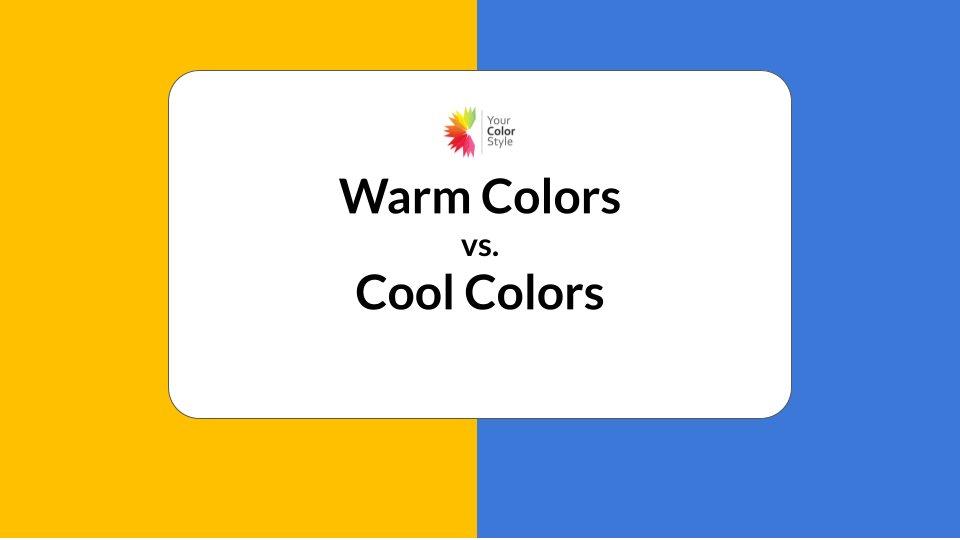Warm Colors vs. Cool Colors

In color analysis, we identify colors that are in harmony with a person's natural coloring and tone. A person's undertones will dictate what types of colors will look best on them.
If a person has cool undertones, cool colors will look best on them.
If a person has warm undertones, warm colors will look best on them.
But what does it mean for a color to be cool or warm?
And why does a certain color temperature harmonize with your coloring versus another color?
I'm going to explain warm colors and cool colors and how these colors harmonize with a person's undertones using color theory.
The Color Wheel
Below is one of the Your Color Style color wheels. It shows the full spectrum of colors in our color palettes. The warm colors are on the right side of the color wheel and the cool colors are on the left side of the color wheel.
In general, the colors on the right will flatter people with warm undertones and the colors on the left will flatter people with cool undertones.
The colors with the stars are universal colors. This means, that no matter what temperature the color is, they will still flatter both warm and cool undertones.

Warm Colors
In general, the warm colors are red, orange and yellow. These are the colors that people associate with warmth. Just think of a fire and you think of red, orange and yellow. But there are more hues than just these colors that are considered warm.
Warm colors are colors made with at least 50% yellow. Although a color may not look warm to you, if it has at least 50% yellow in it, then it is considered warm. All of the colors on the right side of the color wheel, above, are considered warm colors because they are made with at least half yellow. Green is made of equal parts blue and yellow. Red is a primary color. However, in the CMYK printing process and in art, red can also be made with equal parts magenta and yellow.
So, from true red to true green, these colors contain yellow and are warm and are harmonious with people with warm undertones.
Cool Colors
Cool colors are colors made with at least 50% blue. Although a color may not look cool to you, if it has at least 50% blue in it, then it is considered cool. All of the colors on the left side of the color wheel, above, are considered cool colors because they are made with at least half blue. Green is made of equal parts blue and yellow. Green should technically straddle the line on the color wheel, but it was challenging to create this visual. So, imagine that green is on both sides of the warm and cool line. Magenta is not technically made with blue as it stands on its own and can't be created by mixing colors. But it is a cool pink. So, colors made with more than 50% magenta or 50% blue are considered cool.
So, from pink to true green, these colors are made with blue and are cool and are harmonious with people with cool undertones.
Universal Colors
Universal colors are colors that share both cool and warm qualities. They are made with both yellow and blue. These colors are shared between warm and cool undertone color palettes. These colors are blue-greens to green. On the color wheel above, the colors with the stars are universal colors. These colors are not exclusive to warm or cool color palettes.
Primary colors are also universal colors. These colors are blue, red and yellow. Regardless of your undertones, and regardless of the color temperature of these primary colors, they can be worn with both warm and cool undertones.
I often hear the statement, "I wear blue well, so therefore I must have cool undertones." This is a common misunderstanding. Although blue is a cool color, it is a universal color and many individuals with warm undertones.
Color Harmony
In color analysis, we are looking for color harmony. We want the colors you wear to be in harmony with your natural coloring and tones.
In art color theory, colors are harmonious when the colors in a palette share a color. This is the same for understanding the types of colors that will harmonize with you.
If you have warm undertones, then you have a touch of yellow to you. Even if it isn't obvious. The warm colors share yellow with you. Therefore, colors made with yellow will be in harmony with warm undertones.
If you have cool undertones, then you have a touch of blue in your tones. The cool colors share blue with you. Colors made with blue will be in harmony with cool undertones.
Do you know your undertones?
Understanding your undertones is key to learning what colors flatter you. The easiest way to learn your undertones is to put your face inside of the Your Color Style color analysis color wheels. These color wheels are designed to drape you in the colors that will help you SEE if you have warm or cool undertones. Check out the DIY Online Color Analysis course to learn how to get instant access to these color wheels.
You may also like:
- Posted in color analysis, color theory, color undertone, cool colors, warm colors












